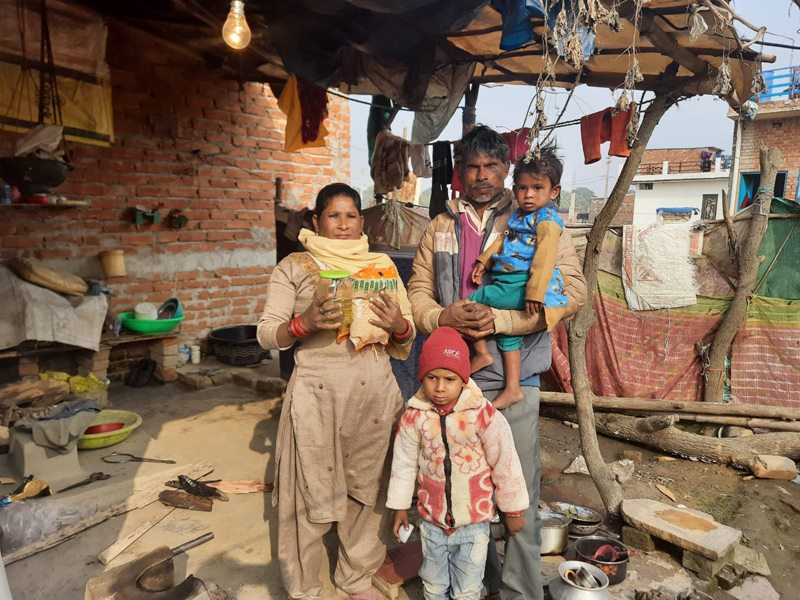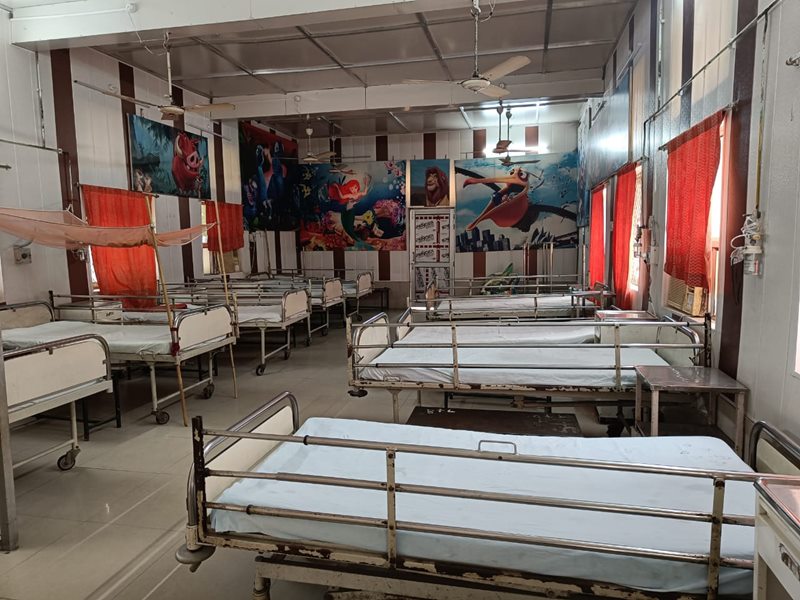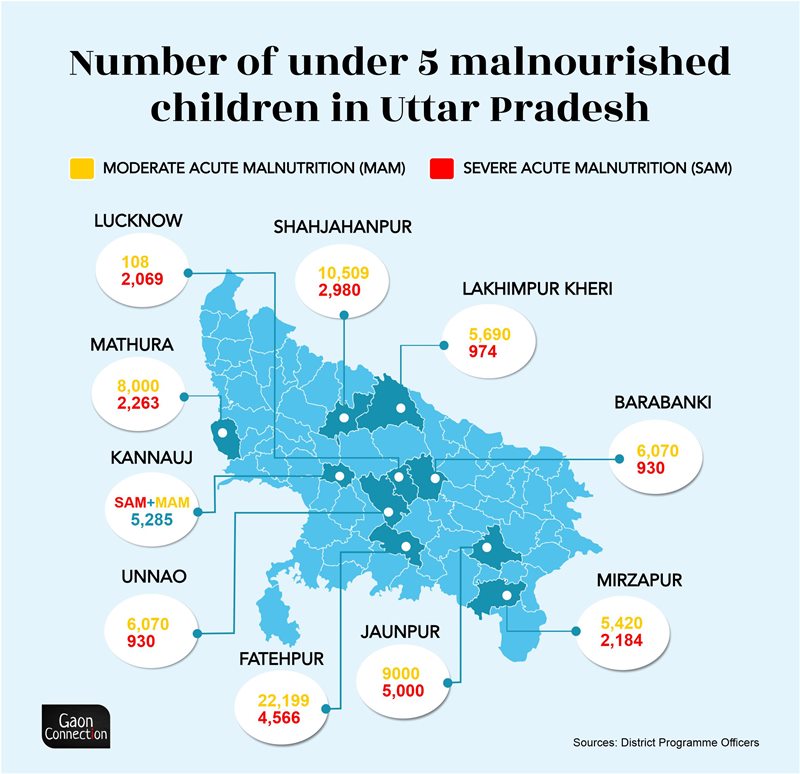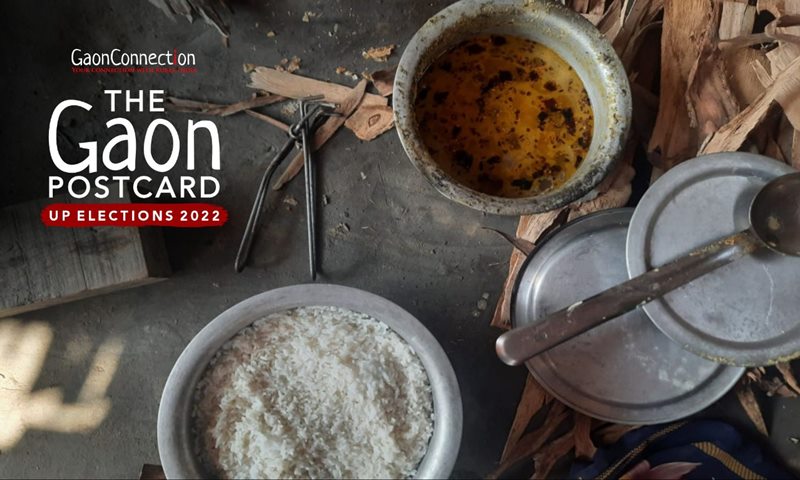If children could vote: In poll-bound UP, high malnourishment but 66% POSHAN funds unutilised
With 41% of under-5 rural kids stunted and 33% underweight, government after government in Uttar Pradesh has made several changes to the anganwadi nutrition programme. Hot meals have been stopped, dry rations are in ‘short supply’ and the state government now plans to merge the anganwadi meals with the mid-day meal scheme. Meanwhile, a large chunk of funds meant to fight malnutrition has remained unutilised between 2017-18 and 2020-21. A ground report as part of ‘The Gaon Postcard’ series.

Lakhimpur Kheri and Lucknow, Uttar Pradesh
On a cold winter morning, two-and-a-half-year-old Rusuda toddled into her home made of plastic sheets, cement bags and rags, hungry. Inside, her mother Sanno was scraping together a meal to feed her little daughter. There was a little bit of leftover dal (lentil), rice and a piece of dry roti (flat bread) from the previous night.
“This is quite a lot considering how poor we are. My husband is a daily wage labourer and he doesn’t find work every day,” Sanno, a resident of Kallan Khera village in Lucknow district, barely 15 kilometres from the Vidhan Bhavan, told Gaon Connection. She is impervious to the fact that her home state goes to polls shortly between February 10 and March 7 and a new government will be announced in the state on March 10.
She has other things to worry about. “My daughter weighs eight kilos, while doctors say she should at least be ten kilos,” 35-year-old Sanno said.

Rusuda falls in the laal shreni (red category) of children. That is, she suffers from severe acute malnutrition (SAM), the worst form of malnutrition that can be life threatening. As of November 2020, the central government had identified 927,606 SAM children between the age groups of six months and six years across the country. Of these, the highest – 398,359 SAM kids, or almost 43 per cent – were in Uttar Pradesh. Lucknow district, where Rasuda lives, has 2,069 SAM and 108 moderate acute malnutrition (MAM) children (under-6 category).
“I have not seen a child nutrition figure in party manifestos. Maybe if these children were a vote bank, there would have been a discussion and focus on malnutrition,” Lucknow-based Sunita Singh, told Gaon Connection. She works with the secretariat of the state’s Right to Food Campaign, a non-profit working for food rights.
However, Sameer Singh, a BJP spokesperson claimed otherwise.“It is only after Narendra Modi ji’s government came to power in 2014 and when Yogi ji became chief minister in 2017, that schemes of the central government on nutrition reached the needy, the poor, and the common people in villages,” he told Gaon Connection.
“Earlier, there were complaints about the quality of midday meals. We have been successful in meeting the hunger and basic needs of villagers. We have worked for five years and in the next five years we will progress fast,” the spokesperson added.
Severely malnourished children like Rusuda need institutional care and there are dedicated Nutrition Rehabilitation Centres at the district hospitals. But Rusuda is not admitted at the rehabilitation centre at Lucknow’s Balrampur hospital that lies 16 kilometres from her home. Occasionally a child is admitted there, as Gaon Connection found when it visited the nutrition rehabilitation centre there on January 20.

“We are not getting referrals from the field. We had our last patient on January 13 [2022],” Uttam Kumar, the incharge at Balrampur hospital told Gaon Connection. We are in touch with anganwadis, CDPOs [chief development project officers] and DPOs [District Project Officers]. We hope patients will come when it gets less cold,” he said.
Over 115-kilometres away, similar concerns were raised by Swapnil Mishra, nutritionist at the nutrition rehabilitation centre in Kannauj district hospital. “Anganwadi and ASHA workers refer children for treatment here. They are not bringing children for treatment these days. It is only when there is strictness that the number of referrals increases,” he told Gaon Connection.
The nutritionist at the Kannauj district hospital went on to inform that last year in 2021, ten malnourished children were brought to the centre in July, eleven in August, six in September, and one each in October and November. According to him, “lack of awareness and shortage of food” were the reasons for malnutrition. The district has a total of 5,285 SAM and MAM children.

Despite its abysmal track record in the matter, the issue of nutrition does not hold centrestage. As per data (December 22, 2021) of the Women and Child Development Ministry, Uttar Pradesh is one of the worst performers in utilising funds allocated for the POSHAN (Prime Minister’s Overarching Scheme for Holistic Nutrition) mission. The state failed to utilise 66.27 per cent of its funds.
Of the total Rs 5,696.896 million funds released by the central government to Uttar Pradesh between financial year 2017-18 and 2020-21, the state has utilised only Rs 1,921.928 million.

Are marginal gains enough?
A recently released NITI Aayog report titled The Healthy States, Progressive India, ranked Uttar Pradesh as the worst-performing state in terms of overall health performance.
However, going by the Union health ministry’s last two National Family Health Surveys (NFHS), the state has made some progress on child nutrition indicators.
As per the NFHS-5 (2019-21), in rural Uttar Pradesh 41.3 per cent of under-5 kids were stunted (low height for age), while 33.1 per cent under-5 kids were underweight (low weight for age). Seventeen per cent rural under-5 kids in the state were categorised as wasted (weight for height), and 7.1 per cent were severely wasted. This is an improvement from 2015-16 where according to NFHS-4, rural areas of the state had 48.5 per cent under-5 stunted kids; 41 per cent underweight kids; 17.9 per cent wasted kids; and 5.8 per cent severely wasted.

“This is a quality jump that Uttar Pradesh has made,” Kapil Singh, director of POSHAN Mission, Government of Uttar Pradesh, told Gaon Connection. “The state is doing fairly well in terms of addressing malnutrition looking at the humongous number of beneficiaries that we have,” he added.
While, according to the POSHAN tracker, the state has 19.6 million beneficiaries registered with its 186,960 anganwadi centres, the POSHAN mission director said there were approximately 11.5 million beneficiaries, including children, pregnant women, and lactating mothers, who were entitled to supplementary nutrition in Uttar Pradesh.
However, there are complaints of anganwadi children not receiving sufficient ration. The hot meals programme was stopped, and the frequent changes in the implementation of the child nutrition schemes in the state were problematic.
Irregular ration supply to kids
It was in 1975 that the Integrated Child Development Services (ICDS) Scheme was introduced to reduce malnutrition and improve nutritional and health status of children. It is one of the world’s largest programmes for early childhood care and development.
Under the ICDS, children in the age group of three to six years are offered hot cooked meals at the anganwadis and half kilogramme of wheat daliya, chana daal, rice each, whereas kids between six months and three years are provided take-home ration that includes one kg wheat daliya, rice, chana dal, and 0.455 kg fortified edible oil every month. Because of the pandemic, the hot meals have been stopped and only dry ration is being offered to the beneficiaries.
As far as severely malnourished children like Rasuda, the government provides 1.5 kg wheat daliya, 1.5 kg rice, two kg chana dal, and 0.455 kg of fortified edible oil every month.
Also Read: ‘Rice and wheat in India are lot less nutritious than they were 50 years ago’
Hot cooked meal programme in ICDS was started to provide nutrition to children from families who struggled to provide enough food to them, said Sunita Singh. “Malnutrition is a big issue in the state and claims lives of many children,” she pointed out. And for a long time, children have no access to hot cooked meals, and sometimes, even the take home ration, the food rights activist added.

“We did serve hot cooked meals but stopped during the pandemic after we did not get a budget. We are giving dry rations to them for morning snacks,” Anil Kumar Verma, Chief Development Project Officer of Ramia Behar block in Lakhimpur Kheri district, informed Gaon Connection.
But, there are complaints of irregular ration supplies.
“We are not getting sufficient dry ration. Sometimes we distribute rations to some beneficiaries in one month and rest in the next month,” Vimla Kumari, anganwadi worker from Lucknow, told Gaon Connection. “There are 22 under-6 children registered in my anganwadi centre but we get ration for only 14,” she added.
“We want ration supply to be increased. People argue with us. Sometimes there are fights, and we are abused,” she said.

Over 280 kilometres away, in Mirzapur district the anganwadi workers complained of a short supply of dry ration for the children. “We get this take home ration in two to three months. We have 48 children in the age group of seven months to three years but we get ration for only 32 children. We have 25 children in the age group of three to six years but we get ration for only 19 children,” 40-year-old Rita Vishwas, an anganwadi worker from Shivala Mahant area in Mirzapur district told Gaon Connection.
Parents also complain of not receiving regular dry ration supplies from the anganwadi. “My child (about six months old) is suffering from pneumonia and is very weak. We sometimes get dal from anganwadi and sometimes edible oil. My child has not been weighed even once in the anganwadi,” 20-year-old Usha, a resident of Gaipura village in Mirzapur district, said. “I have received ration only twice since my pregnancy. I was given chana dal and oil only once,” she added.
Also, parents admit consuming the dry ration that is provided to their children from the anganwadi. “All family members eat whatever we get from the anganwadi for children. The ration is given for children only but when we have excess of it then family members consume it too,” Preeti, a resident of Salpur village in Shahjahanpur district, told Gaon Connection. About 140 under-6 children are registered in the anganwadi centre of Salpur village. Of these, two are malnourished.
Opposition parties have been raising the issue of ‘mismanagement’ of anganwadis. “The Yogi government has fallen short on the nutrition of children in villages. In Mirzapur, primary school kids were given namak roti to eat. During the Samajwadi party government, children were given fruits and milk,” claimed Manoj Singh Kaka, spokesperson, Samajwadi Party.
However, state government officials claim that the child nutrition sector is ‘satisfactory’. “Uttar Pradesh is a huge state, sizewise. During the pandemic, we have reached supplementary nutrition to the doorsteps of beneficiaries. I feel it is a big achievement which our anganwadi workers did during the pandemic,” said Kapil Singh, the state POSHAN mission director.

Fast changing nature of nutrition schemes
Two years of the COVID19 pandemic has impacted nutrition schemes for millions of children. However, much before it, anganwadis in several districts of Uttar Pradesh had stopped providing hot meals to beneficiaries, and had switched to dry rations.
“Earlier, anganwadi workers and helpers would cook food at the centres. We would get around two rupees per child in our accounts for hot cooked meals. We bought rations with that money and cooked khichadi, tehri, meetha daliya. This was in 2017,” Babita Singh, an anganwadi worker from Pratapgarh district, told Gaon Connection.
“Later, the government started paying NGOs to do this. But there were complaints about the quality of food and the scheme was stopped,” she added.
In 2018, ICDS, Uttar Pradesh, issued an order stating that a joint account of anganwadi workers and gram pradhans should be opened to deposit funds to run the hot cooked meal programme in primary schools.
Village heads and anganwadi workers were directed to get food cooked in primary schools under the Mid Day Meal Scheme. The food was sent to anganwadi centres through tiffin services. The government allotted Rs 4.50 per child for hot cooked meals, which included pulses, vegetables, oil, spices, milk, and fruits.
“But, the pradhan stopped receiving the money and the meals stopped,” Babita said.
Meanwhile, another government order dated January 17, 2019, said that in 54 districts out of the total 75 districts in the state, the hot cooked meal programme was to be cooked in primary schools for anganwadi children. In the remaining districts, self help group women were given the responsibility to run the hot cooked meal programme. Gaon Connection has copies of these government orders.
But, Sarika Mohan, director ICDS, Uttar Pradesh blamed the pandemic for the stoppage of the hot meals programme in the anganwadis. “The programme was stopped in 2020 during the pandemic. But we are delivering morning snacks door-to-door along with gehu daliya, fortified rice, chana daal and fortified oil,” she told Gaon Connection.
“We are planning to handover the hot meals programme to the Mid Day Meal authority under the Education department. We will try to simplify the government order so that it is easy to implement,” said Mohan.
“At present the anganwadi workers are under the women and child development department, and they report to the education department. If schools and ICDS centres are based out of one compound it might be a bit easy but most have separate buildings and even different food ingredients,” Sameet Panda, member, Odisha unit of Right to Food Campaign, told Gaon Connection.

Anganwadi workers struggle
“We supplied smartphones to about 1.8 lakh anganwadi workers in the state,” the state Poshan Mission director Kapil Singh told Gaon Connection. “These smartphones are used to transfer data to the poshan tracker application. This is a big achievement,” he added.
However, anganwadi workers complain they are unable to update information. “We were given smartphones in 2017. Mine stopped working after a year. How do we update information such as name, mobile number, Aadhaar, height, and weight of the beneficiaries on the POSHAN tracker when we do not have functional smartphones,” asked Priyanka Singh, an anganwadi worker from Raebareli district.
Also Read: POSHAN on wheels, nutri-kits and mobile anganwadis to tackle malnutrition in Assam
As per the UP government, approximately 60,000 women self help groups (SHGs) are engaged in procurement and distribution of the dry ration. In 11 districts, production units for supplementary nutrition programmes are going to start very soon.
“Once these become self-sufficient, it will not only help giving quality supplementary nutrition to beneficiaries, but it will also make local women self-reliant and ensure quality,” said Kapil Singh.
On December 21, Prime Minister Narendra Modi laid the foundation stone of 202 supplementary nutrition manufacturing units in 43 districts in Uttar Pradesh. The state government has promised to construct supplementary nutrition manufacturing units at every district and block level. Production has already started in Fatehpur and Unnao units.
“We will set up machines and SHG women will profit. Earlier, private companies would supply rations in the state, now we will manufacture it in the district,” Rajendra Srivastava, deputy commissioner, National Rural Livelihood Mission, Lakhimpur Kheri, told Gaon Connection.
“We are also enabling self help groups to procure loader vehicles to distribute the dry rations to anganwadi centres. For this, we will be giving each SHG six lakh rupees at zero interest,” he added.
Describing how the Unnao’s manufacturing unit functions, 39-year-old Ambresh Kumari, member of Annaprashan Prerna Mahila Laghu, a self help group, said: “We take quotations of ration from three markets and buy ration from whichever market is cheaper. We prepare 75 metric tonnes of ration in ten days. After the pushta aahar (nutritious food) is ready, the ration is sent to a laboratory for testing, and then distributed.”
About 20 women work at this supplementary nutrition manufacturing unit in Unnao (for a daily wage of Rs 266) and prepare wheat besan halwa for children between six months and three years of age, and aata besan barfi, moong dal khichdi for children aged three to six years. For malnourished kids, energy rich halwa is prepared, said Ambresh Kumari. This nutritious (dry) food is distributed across 282 anganwadi centres in Sikandarpur block and 175 anganwadi centres in Bighapur block of Unnao district, she added.
With inputs from Brijendra Dubey (Mirzapur), Sumit Yadav (Unnao), Ajay Mishra (Kannauj), Ramji Mishra (Shahjahanpur).

